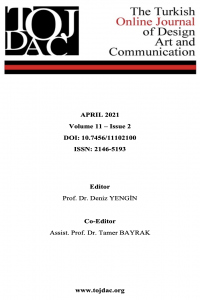Abstract
Doğadaki her organizma birbirini gözetmek suretiyle fonksiyoneldir. Her bir organizma bir diğerini simbiyotik bir ilişki ve/veya form-fonksiyon bağlamında destekler. Örneğin, bazı tür ağaçlar yapraklarını dökerek enerji ve su tasarrufu sağlayarak ağır kış şartları için hazırlık yapar; aynı zamanda bu dökülen yapraklar topraktaki mikroorganizmalar ve mantarlar için önemli birer besin kaynağı haline dönüşür. Doğa ile yapılacak bu tür yaklaşımlar, tasarımların fonksiyonel çözümler üreterek daha iyi yapılı çevreler tasarlanmasına önemli ölçüde yardımcı olabilir ve yadsınamaz bir katkı sağlayabilir. Bu çalışma, doğanın bünyesinde dirençli şehirler tasarlayabilmek için sonsuz çözümler ve fikirler barındırdığını bilimsel bir açıdan incelemektedir. Bu çözümlerin ortaya konabilmesi için başvurulabilecek önemli bir araştırma yöntemi vardır; biyomimikri. Bu bağlamda, çalışmanın araştırma metodolojisi kapsamında biyomimikrinin bir tasarım stratejisi olarak kullanılması amaçlanmıştır. Biyomimikri, biyoloji kullanılarak doğadaki tasarım örneklerinin ortaya çıkarılmasında başvurulan birinci disiplindir. Bu örnekler, ormanların yapısal sağlamlıklarını, biyo-iklimsel özeliklerini, işlevsel morfolojilerini ve diğer önemli özelliklerini ortay koymak için bilimsel birer araştırma alanı olarak değerlendirilmiştir. Bu çalışmanın sonuçları, dirençli ve sürdürülebilir şehirler için en önemli örnek olan ormanların doğal ve sürdürülebilir birer çevre olduklarını, aynı zamanda barındırdıkları tüm organizmalar için en uygun yaşama alanlarını oluşturabilecek kapasiteye sahip olduklarını bilimsel olarak ispatlamayı amaçlamaktadır. Bu bağlamda, elde edilen veriler doğrultusunda konun anlaşılır olması adına seçilmiş bazı örnek tasarımlar ve yöntemler önerilmiştir.
Keywords
Supporting Institution
İSTANBUL KÜLTÜR ÜNİVERİSTESİ
References
- Benus, J., 2014. Cities that Function Like Forests: Biomimicry Maps a Sustainable Future. Keynote Speaker at Geodesign Summit, California, USA.
- Gruber, P., 2011. Biomimetics in Architecture. Architecture of Live and Buildings. Springer Wien, New York, USA.
- Harman, J., 2013. The Shark’s Paintbrush. Biomimicry and How Nature is Inspiring Innovation. Nicholas Brealey Publishing, Boston, USA.
- Kellert, S.R, Heerwagen, J.H, Mador, M.L., 2008. Biophilic Design. The Theory, Science and Practice of Bringing buildings to Life. John Wiley and Sons. New Jersey, USA.
- Karabetça, A.R., 2015. Nature Inspired Architectural Designs: Using Biomimicry as a Design Strategy. International Conference on New Trends in Architecture and Interior Architecture. Proceeding Book p. 143-179. Dubai, United Arab Emirates.
- Mazzoleni, I., 2013. Architecturel Follows Nature. Biomimetic Principles for Innpvative Design. CRC Press, New York, USA. Pawlyn, M., 2011. Biomimicry in Architecture. Riba Publishing, London, UK.
- Pohl, G., and Nachingall, W., 2015. Biomimetics for Architecture and Design. Nature-Analogies-Technology. Springer, Germany. Wohlleben, P., 2016. Ağaçların Gizli Yaşamı, Translated by Ali Sinan Çulhaoğlu, A.S., Publisher Kitap Kurdu, İstanbul. Turkey.
Abstract
Every single organism supports the other either with a symbiotic relationship or in terms of form and/or function. In nature, everything is functional considering each other. For instance, such as some trees shed their leaves to the ground to prepare themselves for strong winter conditions and to create nutrition for microorganisms and fungus under the surface. This kind of interaction with nature could lead architects to develop better solutions to create better-built environments; this is the main objective of this paper. Paper aims to clarify and prove that nature is the greatest mentor and can teach humanity many solutions about designing resilient cities. There is a new and powerful way of seeking solutions in nature; biomimicry. In this context, using biomimicry as a design strategy is the main methodology of this study. Biomimicry is used as a design approach to reach examples in nature by filtering them with biology. These examples are considered to be scientific fields for researching and understanding the structural strength, bioclimatic properties, functional morphology, and other important features of forests which is explained to identify forests and state resilient solutions for developing resilient cities. Outcomes of this paper aim to scientifically state that forests are naturally sustainable environments, which are the greatest examples for resilient cities, and when they unite, they can create the most suitable living environments for all living organisms. Several conceptual ideas and methods are suggested based on the biomimetic design approach to make the argument clear and more understandable.
Keywords
References
- Benus, J., 2014. Cities that Function Like Forests: Biomimicry Maps a Sustainable Future. Keynote Speaker at Geodesign Summit, California, USA.
- Gruber, P., 2011. Biomimetics in Architecture. Architecture of Live and Buildings. Springer Wien, New York, USA.
- Harman, J., 2013. The Shark’s Paintbrush. Biomimicry and How Nature is Inspiring Innovation. Nicholas Brealey Publishing, Boston, USA.
- Kellert, S.R, Heerwagen, J.H, Mador, M.L., 2008. Biophilic Design. The Theory, Science and Practice of Bringing buildings to Life. John Wiley and Sons. New Jersey, USA.
- Karabetça, A.R., 2015. Nature Inspired Architectural Designs: Using Biomimicry as a Design Strategy. International Conference on New Trends in Architecture and Interior Architecture. Proceeding Book p. 143-179. Dubai, United Arab Emirates.
- Mazzoleni, I., 2013. Architecturel Follows Nature. Biomimetic Principles for Innpvative Design. CRC Press, New York, USA. Pawlyn, M., 2011. Biomimicry in Architecture. Riba Publishing, London, UK.
- Pohl, G., and Nachingall, W., 2015. Biomimetics for Architecture and Design. Nature-Analogies-Technology. Springer, Germany. Wohlleben, P., 2016. Ağaçların Gizli Yaşamı, Translated by Ali Sinan Çulhaoğlu, A.S., Publisher Kitap Kurdu, İstanbul. Turkey.
Details
| Primary Language | Turkish |
|---|---|
| Journal Section | Makaleler |
| Authors | |
| Publication Date | April 1, 2021 |
| Submission Date | February 11, 2021 |
| Acceptance Date | March 15, 2021 |
| Published in Issue | Year 2021 Volume: 11 Issue: 2 |


